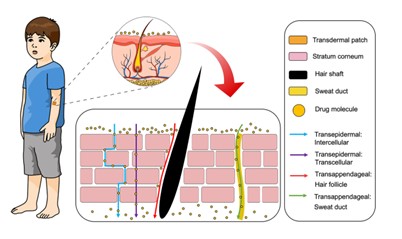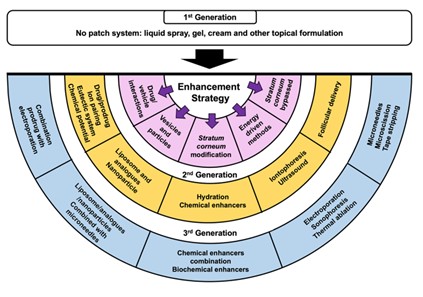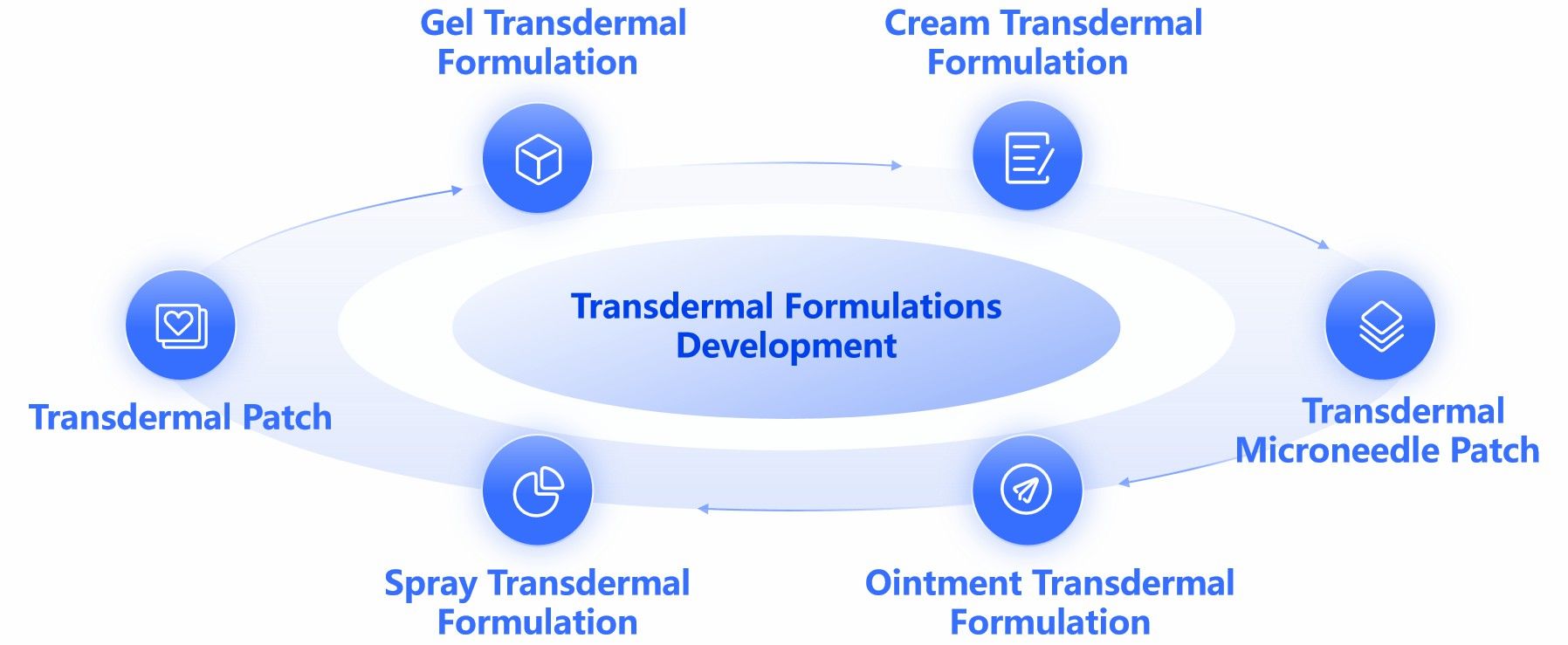Transdermal Delivery Enhancement Technologies
Inquiry
Traditional transdermal drug delivery methods are often constrained by the skin's natural barrier, preventing many drugs from directly entering the bloodstream and achieving adequate bioavailability. To overcome these challenges, CD Formulation offers advanced transdermal delivery technologies. By integrating precise nanocarrier systems, physical enhancement strategies, and chemical enhancement techniques, we significantly improve drug permeability, stability, and efficacy. These innovative solutions support researchers and pharmaceutical development projects in creating more effective transdermal formulations.
Why Enhance Transdermal Drug Delivery?
As a substance in vitro, drugs need to be absorbed through the skin to enter the body, and there are three main ways for drugs to penetrate the body:
1. Through the stratum corneum, not directly through the cell, intercellular penetration and absorption.
2. Through the stratum corneum, directly through the cell for intracellular osmosis and absorption.
3. Infiltration and absorption through skin appendages, such as sweat glands and hair follicles. However, skin appendages are relatively small relative to the overall skin and are not the main pathway.
Among all skin layers, the cuticle barrier has the strongest effect, in which the brick wall structure composed of cuticle cells and intercellular lipids blocks the transdermal absorption of drugs. Hence, enabling drugs to pass through the cuticle is the most important task in the development of transdermal drug delivery systems.
 Fig.1 Schematic representation of transdermal drug delivery mechanisms. (Delly Ramadon, et al.2021)
Fig.1 Schematic representation of transdermal drug delivery mechanisms. (Delly Ramadon, et al.2021)
Our Technology Platform for Enhancing Transdermal Delivery
Due to a skin barrier, most drugs cannot penetrate the skin directly into the blood system, making it difficult to achieve the same bioavailability as other formulations. To improve the bioavailability of transdermal formulations, CD Formulation is commonly used for promoting osmosis, including:
 Fig.2 Summary of the technologies utilized for enhancing transdermal drug delivery. (Delly Ramadon, et al. 2021)
Fig.2 Summary of the technologies utilized for enhancing transdermal drug delivery. (Delly Ramadon, et al. 2021)
Nanotechnology alters drug structure or coats it with special structures. This enhances skin penetration and allows the body to absorb, distribute, and metabolize the drug. Key technologies include liposomes, alcoholsomes, and microemulsions.
Chemical enhancement technology boosts drug solubility in prescriptions and skin. It also alters drug thermodynamics, interacts with stratum corneum lipids and proteins, or forms ion pairs with drugs. Penetration enhancers are grouped into hydrophilic, lipophilic, and amphiphilic types.
Microneedle technology creates patches with tiny, micron-scale needle tips. These needles are painless, non-toxic, and gently irritate the skin. They pierce the epidermis to form drug delivery channels. Drugs can enter deep skin through these channels, bypassing the stratum corneum barrier, and enhancing transdermal absorption.
Energy drive technology mainly enhances the transdermal absorption efficiency of drugs through external energy sources. These technologies leverage physical principles like electric fields, sound waves, and photothermal effects. They help overcome skin barriers and boost drug permeability and bioavailability. Methods include iontophoresis, ultrasonic iontophoresis, microneedles, and electroporation.
Comprehensive Solutions for Transdermal Drug Delivery
We offer tailored transdermal formulation development services designed to meet the specific needs of each project. By considering the unique properties of the drug and customer requirements, we provide personalized adjustments and optimizations to enhance formulation performance, improve drug stability, and ensure effective delivery. Our customized solutions support pharmaceutical companies and researchers in developing innovative transdermal drug products that meet the highest standards of quality and efficacy.
Our services include:
- Develop appropriate targeted delivery strategies and protocols
- Design and optimization of the nanocarrier system
- Evaluate and verify the effectiveness and safety of the delivery system
- Provide customized solutions and technical support
Transdermal Formulations We Can Develop
Based on our technology platform, CD Formulation is dedicated to the development and engineering of all types of transdermal formulations.
 Fig.3 Various types of transdermal formulation development. (CD Formulation)
Fig.3 Various types of transdermal formulation development. (CD Formulation)
Why Choose CD Formulation for Transdermal Innovation?
- Technology Convergence and Application: Our company combines nanomaterials with microneedles, achieving efficient and precise drug delivery. This fusion boosts drug bioavailability and enhances therapy effects.
- Diverse Transdermal Formulation Solutions: We provide a range of tailored transdermal formulation development services, including patches, gels, and lotions. Each formulation is designed to meet the unique properties of the drug and optimize stability, release, and absorption, catering to various research needs.
- R&D Team: Our R&D team is highly qualified and has extensive expertise and experience. They continuously drive innovation in transdermal drug delivery technology.
Publication Data
Technology: Enhance Transdermal Delivery Technologies
Journal: Drug Delivery and Translational Research
IF: 5.7
Published: 2021
Results: Transdermal drug delivery systems have become an intriguing research topic in the pharmaceutical technology area and one of the most frequently developed pharmaceutical products in the global market. The use of these systems can overcome associated drawbacks of other delivery routes, such as oral and parenteral. The authors will review current trends, and future applications of transdermal technologies, to provide a comprehensive understanding of transdermal drug delivery systems and enhancement strategies. This article will initially discuss each transdermal enhancement method used by first-generation transdermal products. These methods include drug/vehicle interactions, particles, stratum corneum modification, energy-driven methods, and stratum corneum bypassing techniques. Through suitable design and implementation of active stratum corneum bypassing methods, notably microneedle technology, transdermal delivery systems have been shown to deliver both low and high-molecular-weight drugs. Microneedle technology platforms have proven to be more versatile than other transdermal systems with opportunities for intradermal delivery of drugs/biotherapeutics and therapeutic drug monitoring. These have shown that microneedles have been a prospective strategy for improving transdermal delivery systems.
CD Formulation is committed to continuous R&D investment, focusing on technological advancement, and product innovation. We deliver high-quality, flexible, and reliable formulation development services tailored to the needs of pharmaceutical companies and researchers. For customized transdermal solutions, contact us, and our team will respond within three business days.
References
- Delly Ramadon, Maeliosa T. C. McCrudden, et al. Enhancement strategies for transdermal drug delivery systems: current trends and applications. Drug Delivery and Translational Research. 2022. 12:758–791.
How It Works
STEP 2
We'll email you to provide your quote and confirm order details if applicable.
STEP 3
Execute the project with real-time communication, and deliver the final report promptly.
Related Services

 Fig.1 Schematic representation of transdermal drug delivery mechanisms. (Delly Ramadon, et al.2021)
Fig.1 Schematic representation of transdermal drug delivery mechanisms. (Delly Ramadon, et al.2021) Fig.2 Summary of the technologies utilized for enhancing transdermal drug delivery. (Delly Ramadon, et al. 2021)
Fig.2 Summary of the technologies utilized for enhancing transdermal drug delivery. (Delly Ramadon, et al. 2021) Fig.3 Various types of transdermal formulation development. (CD Formulation)
Fig.3 Various types of transdermal formulation development. (CD Formulation)
